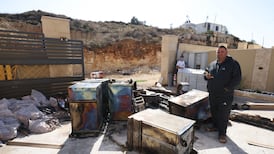"Evacuate," said the voice at the other end the line. It was 8.50pm, just over 90 minutes before Israel would confirm it had launched a ground operation in the Gaza Strip. The hospital was at risk.
Its 17 patients, all profoundly disabled and receiving therapy at this specialised institution facing Gaza’s eastern border with Israel, had been kept together on the first floor wards.
Abu Medhat al-Ashi, al-Wafa hospital’s executive director, says the shelling began about 10 minutes after the call. “Some of the shells penetrated the whole building, from one side to another and hit the next building. Fire broke out inside, electricity was cut, water was cut off and there was a leak,” he says.
All 17 patients are paralysed, so the hospital staff faced a difficult task. They scrambled to track down ambulances from across the beleaguered city; as each vehicle arrived, one-by-one, the medics carried the patients out the door with their sheets. By 11pm the hospital was empty.
Lying in bed at the Sahaba medical complex, a private charity-run clinic that agreed to accommodate the patients, 16-year-old Aya Abdan says she is still afraid when she thinks about the previous night.
She has lost all feeling in her legs as a result of a tumour in her spinal cord. “Glass broke and the hospital was full of dust so you couldn’t see anything,” she recalls.
Shrapnel damage
After a previous incident in which al-Wafa was hit on Wednesday, the Israel Defence Forces said it had bombed a rocket launcher situated 300m from the hospital and the hospital was damaged by shrapnel.
It said an advance warning was given before the strike was carried out and that it had urged hospital staff to evacuate.
The hospital’s director, whose efforts are focused on replenishing the stock of drugs destroyed, is reeling.
“You have seen my patients,” he says insistently. “They are in no way a threat to the Israelis. How could they be? We are not a military building, we are not a strategic building. We are a hospital, improving the lives of people in Gaza.”
Across town in Shifa hospital, Gaza’s largest, the emergency department is calm after one of its busiest nights. All through Thursday night and early yesterday morning, the sky was alight with orange flares as Israel deployed a formidable force of fighter jets, naval ships, Apache helicopters and drones to ease the path for its troops on the ground. According to the local health ministry, more than 20 people died and 250 were injured overnight.
Burial of bodies
Outside the hospital morgue, a ramshackle building that has been in heavy use this week, a crowd has gathered to watch the bodies emerge for burial. Usually it takes four men to lift a corpse, each one covered in a white sheet, and put it into the back seat of a car. One of the bodies is that of
Mohammed Abdel Rahman
, who friends say was killed repairing a mobile phone antenna on the roof of a building in Gaza City. They think he was hit by a drone.
Medic Hussein Baraqa is waiting for the next call. His shifts alternate between the ambulance and the emergency room, but admits he feels travelling at night – when roads are deserted – is too dangerous. But he still goes out?
“It’s my duty,” he shrugs. “I have to.”











